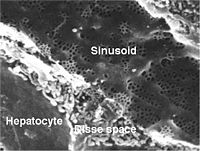
Photo from wikipedia
BACKGROUND A recent advancement in isolation and cryopreservation has resulted in commercially available primary human enterocytes that express various drug metabolizing enzymes (DMEs) and transporters. The main objective of this… Click to show full abstract
BACKGROUND A recent advancement in isolation and cryopreservation has resulted in commercially available primary human enterocytes that express various drug metabolizing enzymes (DMEs) and transporters. The main objective of this study was to further evaluate the utility of pooled cryopreserved enterocytes, specifically MetMax™ cryopreserved human enterocytes (In vitro ADMET Laboratories), as an in vitro model for assessing intestinal clearance in comparison to hepatocytes. METHODS It was found that, for CYP3A4/5 substrates such as midazolam, amprenavir and loperamide, in vitro metabolic clearance is generally lower in enterocytes compared to that of hepatocytes, which is consistent with the relative abundance of the enzyme between the intestine and liver. In contrast, raloxifene, a surrogate UGT activity substrate, showed 3-fold greater turnover in enterocytes than hepatocytes, which is likely attributed to the differential expression of individual UGTs in human liver and intestine. For procaine, a known CES2 substrate, the measured apparent clearance was higher in hepatocytes, but formation of 4-aminobenzoic acid, a CE2-specific metabolite, was more pronounced in enterocytes, suggesting that CE2 is more active in enterocytes. Salbutamol, a SULT1A3 substrate, showed little turnover in both enterocytes and hepatocytes, and more abundant sulfate conjugate was detected in enterocytes, indicating higher SULT activity in enterocytes than hepatocytes. As expected, ketoconazole inhibited CYP3A4/5-mediated metabolite formation in enterocytes for midazolam, amprenavir and loperamide, suggesting that cryopreserved enterocytes may be useful in determining intestinal CYP3A inhibition parameters. Interestingly, elacridar, a P-gp inhibitor, suppressed metabolite formation in enterocytes for loperamide, a substrate of CYP3A4 and P-gp, suggesting that enterocytes in suspension do not have active P-gp efflux functions, and the suppression of metabolism in enterocytes is probably caused by inhibition of CYP3A4/5 by elacridar. RESULTS Our results suggest that pooled cryopreserved human enterocytes, specifically the MetMax™ cryopreserved human enterocytes, represent a valuable in vitro model for assessing first-pass clearance and potential drug interactions in human intestine.
Journal Title: Drug metabolism letters
Year Published: 2018
Link to full text (if available)
Share on Social Media: Sign Up to like & get
recommendations!